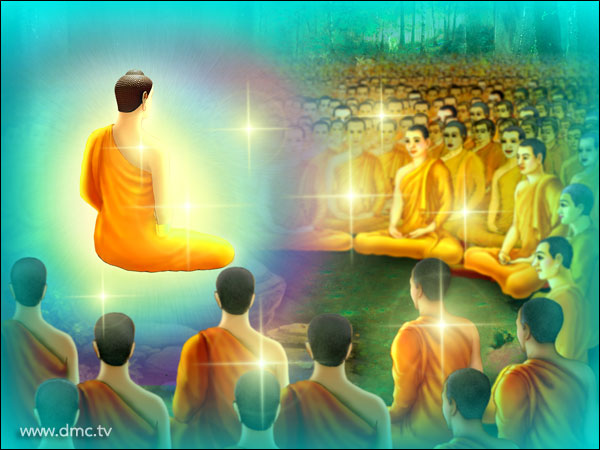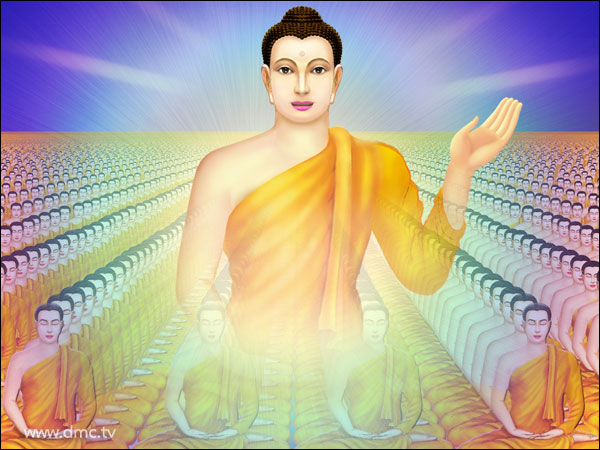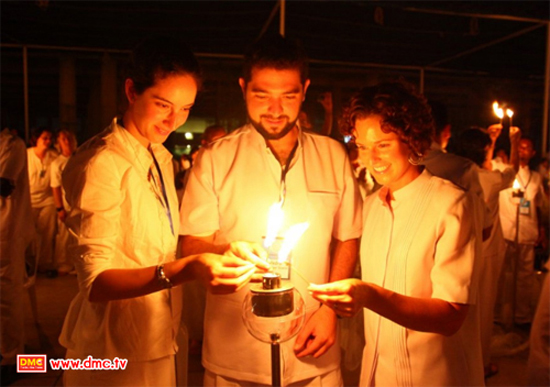คําศัพท์ภาษาอังกฤษ
Magha Puja Day วันมาฆบูชา
คําศัพท์ภาษาอังกฤษ
ตอน Magha Puja Day
วันมาฆบูชา
ตอน Magha Puja Day
วันมาฆบูชา
welcome to I like English
รายการที่จะทำให้คุณชอบภาษาอังกฤษมากขึ้น
รายการที่จะทำให้คุณชอบภาษาอังกฤษมากขึ้น
โดย สุภักพร ตรีสุผล (สตาร์) & Aj.Shon Pistoll

Magha Puja Day วันมาฆบูชา
We can explain easily by telling them about the history of Magha Puja Day. เรามาเริ่มต้นอธิบายว่าวันมาฆบูชาเป็นวันอะไร
Magha Puja Day is held on the Day of the full moon of the third lunar month which is in February or March. แปลว่า วันมาฆบูชาเป็นวันเพ็น 15 ค่ำ เดือน 3 ซึ่งตรงกับเดือนกุมภาพันธ์ หรือมีนาคมค่ะ
We think of it as the day of the "Dhamma" because this is the day when the Lord Buddha concluded his Dhamma Teachings and laid down the guidelines for his disciples to spread the Dhamma accor ding to the same high standards. แปลว่า วันนี้เราเรียกอีกอย่างว่า "วันพระธรรม" เพราะเป็นวันที่พระสัมมาสัมพุทธเจ้าท่านได้สรุปพระธรรมคำสอนของท่าน และได้วางหลักเกณฑ์สำหรับพระอรหันตสาวกทั้งหลายเพื่อที่จะเผยแผ่ธรรมะออกไป ด้วยมาตรฐานที่สูงในระดับเดียวกัน
Guideline แปลว่า หลักเกณฑ์
Disciple แปลว่า ลุกศิษย์, สาวก
Spread แปลว่า เผยแผ่
More than two thousand five hundred years ago in Veluvana Bamboo grove. All 1,250 of the Arahants who had freed themselves of impurities and were ordained by the Lord buddha. They assembled spontaneously to hear the Fortunate One's teaching of the Pvada patimokkha. แปลว่า กว่าสองพันห้าร้อยปีที่ผ่านมา ในป่าไผ่เวฬุวัน เหล่าอรหันตสาวกทั้ง 1,250 องค์ผู้ซึ่งได้เป็นอิสระจากความไม่บริสุทธิ์ทั้งปวงและได้รับการบวชโดยพระสัมมาสัมพุทธเจ้า ท่านได้มารวมประชุมกันครั้งยิ่งใหญ่เพื่อฟังคำสอนอันทรงคุณค่าในหัวข้อ "โอวาทปาฏิโมกข์"
Bamboo Grove แปลว่า ป่าไผ่
Impurity แปลว่า ไม่บริสุทธิ์
Individual แปลว่า แต่ละบุคคล
Spontanepusly แปลว่า อย่างยิ่งใหญ่

1,250 disciples came to see Buddha that evening without being summoned. All of them were Arhants or Enlightened Ones.
Ovada Patimokkha is said to be the heart and essence of Buddhist practice for individuals. แปลว่า โอวาทปาฏิโมกข์เป็นหัวใจของการที่จะปฏิบัติตนของชาวพุทธแต่ละคน
Practice แปลว่า การปฏิบัติ
Individual แปลว่า แต่ละบุคคล
But at that time, the Buddha did not mean this practice is only for individuals but also for teaching how monks should conduct themselves in order that the Sangha and Buddhism should remain unified and be practiced by future generations. แปลว่า แต่ในเวลานั้น พระสัมมาสัมพุทธเจ้าไม่ได้หมายความแต่ในการปฏิบัติส่วนตนเท่านั้น แต่ยังหมายถึง วิธีการที่พระสงฆ์ถึงปฏิบัติ เพื่อที่ว่า หมู่สงฆ์ และพุทธศาสนาจะสามารถรวมเป็นหนึ่งเดียวและได้รับการปฏิบัติสู่ผู้คนในรุ่นต่อไป
In conclusion, Magha Puja ay marks four auspicious occasions, แปลว่า วันมาฆบูชาได้มีเหตุการอันเป็นมงคล 4 อย่าง
First: 1,250 disciples came to see Buddha that evening without being summoned. All of them were Arhants or Enlightened Ones. แปลว่า พระสงฆ์ 1,250 องค์ มาประชุมรวมกันโดยมิได้นัดหมาย และทั้งหมดล้วนตรัสรู้เป็นพระอรหันต์
Summon แปลว่า การเรียกประชุม
Secondly: All of them were ordained by Buddha himself. แปลว่า พระอรหันต์ทั้งหมดนี้ ล้วนได้รับการบวชแบบ เอหิภิกขุอุปสัมปทาคือพระสัมมาสัมพุทธเจ้าเป็นผู้ประทานการบวชให้ได้โดยพระองค์เอง
Thirdly: The Buddha gave "The Ovada patimokkha". These principles are: To cease from all evil, To do what is good, and to cleanse one's mind. แปลว่า พระสัมมาสัมพุทธเจ้า ได้ให้โอวาทปาฏิโมกข์ซึ่งเป็นหลักเกณฑ์ในการปฏิบัติละชั่วทำดี ทำใจให้ผ่องใสค่ะ
To cease from all evil แปลว่า ละชั่ว
To do what is good. แปลว่า ทำดี
To cleanse one's mind. แปลว่า ทำใจให้ผ่องใส
And fourthly: It is on the day of the full-moon. แปลว่า เป็นวันพระจันทร์เต็มดวงค่ะ

The Buddha gave "The Ovada patimokkha". These principles are:
To cease from all evil, To do what is good, and to cleanse one's mind.
To cease from all evil, To do what is good, and to cleanse one's mind.
On Magha Puja Day, there is traditionally lighting of candle, circumambulation and meditation to pay homage to the Lord Buddha. แปลว่า ในวันมาฆบูชามีประเพณีในการจุดประทีปเดินเวียนประทักษิณและปฏิบัติธรรมเพื่อถวายเป็นพุทธบูชาแด่พระสัมมาสัมพุทธเจ้า
Circumambulation แปลว่า การเวียนเทียน
Homage แปลว่า แสดงความเคารพ
The lighting of the candles is a symbol for the illuminating of the Dhamma and wisdom that abounds for those who follow the teaching of the Lord Buddha. แปลว่า การจุดประทีปนี้เป็นสัญลักษณ์ของความสว่างไสวรุ่งเรืองในธรรมและปัญญา อันไม่มีประมาณ สำหรับผู้ที่ดำเนินรอยตามคำสอนของพระบรมศาสดา
Symbol แปลว่า สัญลักษณ์
Illuminating แปลว่า ความสว่างไสว, รุ่งโรจน์
Wisdom แปลว่า ปัญญา
Abound แปลว่า มากมาย อุดมไปด้วย
Finally, you can invite people to join Magha Puja Day's ceremony by saying "Let's join Magha Puja Day's ceremony together." แปลว่า เราสามารถชวนชาวต่างชาติมาร่วมงานวันมาฆบูชาได้ว่า
"Let's join the Magha Puja Day's ceremony together." แปลว่า มาร่วมงานวันมาฆบูชาด้วยกัน

Let's join the Mangha Puja Day's ceremony together.
Today we've learned a lot of vocabulary about "Magha Puja Day" as well as other useful words. For example;
Giodeline = หลักเกณฑ์
Spread = เผยแผ่
Bamboo = Grove ป่าไผ่
Impurity = ไม่บริสุทธิ์
Spontanepusly = อย่างยิ่งใหญ่
Circumambulation = การเวียนเทียน
Illuminating = ความสว่าวไสว, รุ่งโรจน์
รับชมวิดีโอ








